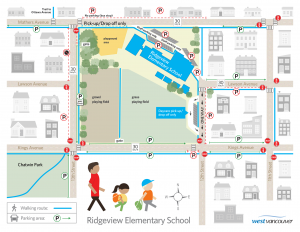Getting to School Safely
February 12, 2018 - 6 minutes readDon’t look now, but the kids are Watching!
School safety begins before children arrive at school, and it doesn’t end until they arrive safely back at home.
What steps can parents take to make sure the journey is a safe one for a student?
A good place to start is to consider how your child gets to school, from the moment she walks out the front door of your home to the moment she sets foot inside the school and vice versa on the way home. Whether students are travelling to school by foot, bicycle, car or bus, there are steps you can take to help them make their safety a priority, whether coming or going.
Walking to school is the healthiest and safest way to get to school.
However, many parents or siblings of elementary students, opt to drive their children to school. Taking the time to be a safe driver is all the more important when children are in the vehicle, especially during the morning and evening rush hours, when traffic is often at its heaviest. If you are driving children to school, please give yourself enough time to drive, park, and drop off the children safely.
Remember, there is NO student pick up or drop off in the Ridgeview staff parking lot. The staff parking lot is limited in space and is reserved for staff and visiting professionals. Please take time to observe the parking signage around the school. There is ample parking as marked around the school. Make a habit of dropping off or picking up in one of the designated spaces and discuss and/or practice walking safety into the school with your child.
Children learn best by watching what parents, adults, or other childcare providers do. They tend toward doing what you do more than doing what you say. Following are some pedestrian safety tips (RoadSense Kids: Smart Choices, ICBC) for you to share with the children and a refresher to help you model safe pedestrian practices.
- Always walk on the inside edge of the sidewalk away from the curb or roadway. The outer edge of the sidewalk leaves a child more exposed to vehicles and a child could dash out or fall onto the roadway.
- If there’s no sidewalk, always walk facing traffic so you can see oncoming vehicles and drivers can see you. Practise with the child to show the safe way to walk on these roads.
- Dress to be seen. Bright clothing makes it easier for drivers to see you during daytime. When walking at dusk, night, or in poor weather wear reflective material on your shoes, cap or jacket so drivers can see you.
- Steps to crossing safely:
- Stop before stepping onto a road, driveway or lane.
- Look in all directions – left-right-left and look over your shoulder for vehicles that may be turning.
- Listen for approaching vehicles that aren’t visible yet but could be coming from a driveway, around a corner or over a hill.
- Make eye contact with drivers, so you know they see you and they know you see them. Pedestrians often assume that if they can see the car, the driver can see them.
- Check that vehicles have stopped before you step off the curb or road.
- Obey all traffic signs. During walks and drives, point out and explain a wide variety of traffic signs and signals to children so they become familiar with them and what they mean.
- Walk, don’t run, across the street, roadway or lane. Keep looking for approaching vehicles as you cross – left-right-left and over your shoulder.
- Don’t wear headphones or talk/text on the phone when crossing the street; you won’t be able to hear signs or danger.
- Don’t jaywalk. Cross only at corners or marked crosswalks.
- Parked vehicles can be dangerous. They can block pedestrians from a driver’s view and block approaching vehicles from a pedestrian’s view. Stop, look left-right-left around the parked car before crossing, then proceed if it’s safe to do so.
- Parking lots require special attention. Vehicles can back up or move without warning and drivers are often distracted. Hold your child’s hand at all times. If you’re carrying bags in both hands, have the child hold onto your clothing or legs. Seat the child in the vehicle before loading the bags.
It is important to ensure that children of all ages learn and practise road safety skills as they become increasingly independent. They often need reinforcement and reminders about safe walking, cycling, school bus and car passenger skills, and judgment calls related to peer pressure.
Adult support is needed to ensure children are developing road safety awareness and developing an understanding of critical life skills to be safe in all traffic situations.
Parents, please reinforce the safe walk routes to Ridgeview. Refer to the attached map for parking and walking expectations.
How are you teaching road safety to your children?

Recent Comments